Странник — самый загадочный персонаж средневековых бестиариев. Даже устных свидетельств не сохранилось.
Bestiary.us
энциклопедия вымышленных существБыстрый переход
- Городские легенды Cовременная разновидность мифов, как правило, короткие, и, на первый взгляд, правдоподобные (хотя обычно не соответствующие действительности) истории, опирающиеся на современную техническую и общественную реальность, обычно затрагивающие глубинные проблемы и страхи современного общества.
- Средиземье Средизе́мье (англ. Middle-earth, буквально Среди́нная земля́, также существуют варианты перевода Среднеземье, Средьземелье) — одна из первых и самых известных фэнтези-вселенных. Оно является местом действия основных произведений Дж.Р.Р.Толкина, а также «вольных продолжений» других авторов.
- Мир Гарри Поттера Вымышленный мир, в котором происходит действие серии романов о юном волшебнике Гарри Поттере. Действие происходит в нашем мире, в Англии, в 1990-х годах. В отличие от реального мира, среди обычных людей (маглов) живут волшебники (маги), обладающие способностью к использованию магии.
Аспид
Аспид — в христианстве, средневековых европейских бестиариях и в славянской мифологии крылатая змея, опустошающая земли
Asp — according to medieval christian sources, deadly snake which presses one ear against the ground and blocks and closes up the other with its tail to not hear the magic words of enchanter
Аспид — в христианстве, средневековых европейских бестиариях и в славянской мифологии крылатая змея, опустошающая земли
Asp — according to medieval christian sources, deadly snake which presses one ear against the ground and blocks and closes up the other with its tail to not hear the magic words of enchanter
Аспид — в христианстве, средневековых европейских бестиариях и в славянской мифологии крылатая змея, опустошающая земли
АспидВ христианстве, средневековых европейских бестиариях и в славянской мифологии крылатая змея, опустошающая земли по-русскиAspAccording to medieval christian sources, deadly snake which presses one ear against the ground and blocks and closes up the other with its tail to not hear the magic words of enchanter in english
Asp —
Aspic —
Aspid —
Aspide —
Aspis —
Аспида —
Аспик —
Ехидный —
Пестрый змей —
"На аспида и василиска наступишь; попирать будешь льва и дракона"
Псалом 90:13 (7)
По славянской мифологии, а также в ряде средневековых европейских бестиариев, аспид — это "крылатая змея, которая нос имеет птичий и два хобота. В какие края летать повадится, те места опустошит; живет в горах и на землю никогда не садится, только на камень. Его невозможно убить стрелою, можно только сжечь" (8).
"На мрачном, суровом, лесистом севере народная фантазия помещала змею аспиду...; эта змея, по народному мнению, жила в печерских горах, не садилась па землю и на камень..." (48).
"Сие есть змей зело грозный. Перемещается с быстротою молнии, а из пасти его постоянно пар горячий извергается. ежели укусит, человек распухает страшно и заживо гниет" (49: с.277).
"Заговорить, уничтожить разрушающую все вокруг себя аспиду могли, по поверьям, колдуны, "знахари обаянники", которые использовали нелюбовь аспиды к "трубному гласу":
Пришедше же обаянницы, обаяти ю, и копают ямы, и садятся в ямы с трубами, и покрывают дном железным и замазываются суглинком, и ставят у себя уголие горящее: да разжигают клещи и егда вострубят, тогда она засвищет, яко горы потряситися, и прилете к яме, ухо свое приложит на землю, а другое заткнет хоботом...
Мечущуюся "от трубного гласа" аспиду знахари обаянники хватали и держали раскаленными клещами, пока она не погибала..." (48).
"3верь сей также хитростию превеликой отличается. Ежели его колдун формулою магическою, либо заклинатель флейты музыкою сладостною одурманить пожелает, аспид, дабы заклинания либо игры музыкальной не слышать, так сворачивается, что одно ухо к земле прижимает, другое же хвостом себе затыкает. Делает он так по образу и подобию богача, коий одно ухо завсегда к благам земным приходящим наставляет, другое же грехом затыкает. Сравню таковых со змеем аспидом, псалом 57:5: "Яд у них, как яд змеи, как глухого аспида, который затыкает уши свои" (49: с.277-278).
Именно так, лежа одним ухом на земле и прикрыв второе хвостом, традиционно показан аспид на иллюстрациях средневековых манускриптов. Часто рядом с ним изображали человека, читающего текст заклинания или играющего на флейте. Интересен и тот факт, что с одной стороны в бестиариях аспидами называли, в принципе, любых ядовитых змей, а с другой — их нередко изображали не как пресмыкающихся, а скорее как зверей — с шерстью, львиными лапами и мордой.
12. Aspis vocata, quod morsu venena inmittat et spargat ; ιοσ enim Graeci venenum dicunt : et inde aspis, quod morsu venenato interimat. Huius diversa genera et species, et dispares effectus ad nocendum. Fertur autem aspis, cum coeperit pati incantatorem, qui eam quibusdam carminibus propriis evocat ut eam de caverna prducat : illa, cum exire noluerit, unam aurem in terram premit, alteram cauda obturat et operit, atque [ita] voces illas magicas non audiens non exit ad incantantem.
Isidori Hispalensis Episcopi Etymologiarum Sive Originum, XII.4.12 (88)
12. Аспид (Aspis) назван так, потому что укусом впрыскивает (spar-gat) яд; ведь греки называют яд ios (as), отсюда — название aspis, так как он убивает ядовитым укусом. Существуют различные виды аспидов, отличающиеся видом и способом нанесения вреда. Сообщают, что, когда чародей начинает заклинаниями вызывать аспида из норы, он, не желая выходить, прижимает одно ухо к земле, а другое затыкает хвостом; так, не слыша магических слов, аспид не выходит к заклинателю.
13. Дипсада (Dipsas), род аспида, по-латыни называется "воронка" (situla), потому что укушенный ею умирает от жажды (siti).
14. Гипнал (Hypnalis или Ipnalis) — род аспида, убивающий сном. Клеопатра поднесла его к себе, и смертью была охвачена, словно сном.
15. Геморроем (Hoemorrois или Haemorrhois) называется аспид, укус которого вызывает у жертвы кровавый пот, так что с кровью, сочащейся из размягченных вен, исходит остаток жизненных сил. По-гречески же кровь называется haima.
16. Престер (Proester) — аспид, что всегда держит открытой обжигающую пасть. Поэт так упоминает ее: "Предстоит, ненасытный, раскрыв дымящийся рот". Тот, кого поражает эта змея, распухает и погибает от чрезмерной величины тела; за опухолью следует нагноение.
17. Сепс (Seps) — растопляющий аспид: укушенный им погибает немедленно, так как все расплавляется в пасти этой змеи.
Из "Этимологии" Исидора Севильского (118),
Книга XII "О животных", глава 4 "О гадах"
Также "близкие аспиду существа: Змей Горыныч, Василиск, Ехидна" (8). Кроме того, нередки случае, когда в текстах бестиариев или при работе с ними (например, при переводах) понятия "аспид" и "ехидна" смешиваются.
"Некоторые исследователи (в частности, Н.Сумцов) считают, что змеи-летавцы и упыри народных поверий — существа, сходные с "книжным" аспидом" (48).
"У крестьян Архангельской губернии аспид — "ехидный", но опять-таки связуется с представлением о змее" (48).
According to medieval christian sources, the asp is a deadly serpent that avoids the enchantment of music by pressing one ear against the ground and plugging the other ear with its tail. In some versions the asp guards a tree that drips balm; to get the balm men must first put the asp to sleep by playing or singing to it. Another version holds that the asp has a precious stone called a carbuncle in its head, and the enchanter must say certain words to the asp to obtain the stone.
The Haemorrhois, Prester and Hypnalis are other varieties of asp.
"...they are like the deaf adder that stops her ear; which will not hearken to the voice of charmers, charming never so wisely".
Bible. Psalm 58:5-6 (7)
"First from the dust was raised a gory clot
In guise of Asp, sleep-bringing, swollen of neck:
Full was the blood and thick the poison drop
That were its making; in no other snake
More copious held. Greedy of warmth it seeks
No frozen world itself, nor haunts the sands
Beyond the Nile; yet has our thirst of gain
No shame nor limit, and this Libyan death,
This fatal pest we purchase for our own".
Lucan "Pharsalia", book 9, verse 821-839. 1st century CE
"Haemorrhois huge spreads out his scaly coils,
Who suffers not his hapless victims' blood
To stay within their veins".
Lucan "Pharsalia", book 9, verse 830-832. 1st century CE
"Greedy Prester swells / His foaming jaws...".
Lucan "Pharsalia", book 9, verse 845-846. 1st century CE
"...a Prester's fang
Nasidius struck, who erst in Marsian fields
Guided the ploughshare. Burned upon his face
A redness as of flame: swollen the skin,
His features hidden, swollen all his limbs
Till more than human: and his definite frame
One tumour huge concealed. A ghastly gore
Is puffed from inwards as the virulent juice
Courses through all his body...".
Lucan "Pharsalia", book 9, verse 928-936. 1st century CE
"On Tullus great in heart,
And bound to Cato with admiring soul,
A fierce Haemorrhois fixed. From every limb,
(As from a statue saffron spray is showered
In every part) there spouted forth for blood
A sable poison: from the natural pores
Of moisture, gore profuse; his mouth was filled
And gaping nostrils, and his tears were blood.
Brimmed full his veins; his very sweat was red;
All was one wound".
Lucan "Pharsalia", book 9, verse 946-955. 1st century CE
Described here is the battle between Asp and Ichneumon and the latter is usually is said to be the one that covers itself with mud.
XXXVI mergit se limo saepius siccatque sole, mox ubi pluribus eodem modo se coriis loricavit, in dimicationem pergit. in ea caudam attollens ictus inritos aversus excipit, donec obliquo capite speculatus invadat in fauces. nec hoc contentus aliud haud mitius debellat animal.
Gaius Plinius Secundus "Naturalis Historia", VIII.36.88 (112: Vol.III, p.64)
XXXVI. The asp repeatedly plunges into mud and dries itself in the sun, and then when it has equipped itself with a cuirass of several coatings by the same method, it proceeds to the encounter. In this it raises its tail and renders the blows it receives ineffectual by turning away from them, till after watching for its opportunity, with head held sideways it attacks its adversary's throat. And not content with this victim it vanquishes another animal no less ferocious, the crocodile.
Pliny the Elder "Natural History", VIII.36.88 (112: Vol.III, p.65)
XXXV Quod ad serpentis attinet, vulgatum est colorem eius plerasque terrae habere in qua occultentur; innumera esse genera : <…> colla aspidum intumescere nullo ictus reraedio praeterquam si confestim partes contactae amputentur.
Gaius Plinius Secundus "Naturalis Historia", VIII.35.85 (112: Vol.III, p.62)
XXXV. As concerning serpents, it is generally stated that most of them have the colour of the earth that they usually lurk in; that there are innumerable kinds of them; <…> that when asps' necks swell up there is no remedy for their sting except the immediate amputation of the parts stung.
Pliny the Elder "Natural History", VIII.35.85 (112: Vol.III, p.63)
Sicut enim dicuntur aspides, quando incantantur, ut non prorumpant et exeant de cavernis suis, premere unam aurem ad terram, et de cauda sibi alteram obturare, et tamen incantator producit illas...
As indeed of asps it is said, that when they are lured by incantations, in order that they may not be drawn from their caves they press one ear to the ground, and use their tail to stop up the other, and yet the enchanter can bring it forth...
Augustine of Hippo "Sermo" 316:2 — In Solemnitate Stephani Martyris; Duri Iudaei in Stephanum. 5th century CE
This appears to be the first time this method of blocking both ears was described.
12. Aspis vocata, quod morsu venena inmittat et spargat ; ιοσ enim Graeci venenum dicunt : et inde aspis, quod morsu venenato interimat. Huius diversa genera et species, et dispares effectus ad nocendum. Fertur autem aspis, cum coeperit pati incantatorem, qui eam quibusdam carminibus propriis evocat ut eam de caverna prducat : illa, cum exire noluerit, unam aurem in terram premit, alteram cauda obturat et operit, atque [ita] voces illas magicas non audiens non exit ad incantantem.
Isidori Hispalensis Episcopi Etymologiarum Sive Originum, XII.4.12 (88)
12.The asp (aspis) is named thus because with its bite it introduces and scatters (spargere) venom, for the Greeks call venom ιοσ. Whence the term "asp", because it kills with a venomous bite. There are different kinds with different appearances, some more harmful than others. And it is said that when an asp begins to give in to an enchanter who has called it with certain special chants so that he may draw it from its cave, and the asp does not want to come out, it presses one ear against the ground and blocks and closes up the other with its tail [so that] by not hearing the magic words it does not go out to the enchanter.
Isidore of Seville "Etymologies", XII.4.12 (1175: p.256)
"The emorrosis is an asp, so called because it kills by making you sweat blood. If you are bitten by it, you grow weak, so that your veins open and your life is drawn forth in your blood. For the Greek word for 'blood' is emath. ... The prester is an asp that moves quickly with its mouth always open and emitting vapour... If it strikes you, you swell up and die of gross distention, for the swollen body putrefies immediately after... There is a kind of asp called ypnalis, because it kills you by sending you to sleep. It was this snake that Cleopatra applied to herself, and was released by death as if by sleep."
Aberdeen Bestiary, c.1200 CE
Онлайн источникиАнлайн крыніцыŹródła internetoweОнлайн джерелаOnline sources
Статус статьиСтатус артыкулаStatus artykułuСтатус статтіArticle status:
Процессия (незаконченная статья в процессе написания)
Подготовка статьиПадрыхтоўка артыкулаPrzygotowanie artykułuПідготовка статтіArticle by:
Адрес статьи в интернетеАдрас артыкулу ў інтэрнэцеAdres artykułu w internecieАдрес статті в інтернетіURL of article: //bestiary.us/aspid




Культурно-географическая классификация существ:
Культурна-геаграфічная класіфікацыя істот:
Kulturalno-geograficzna klasyfikacja istot:
Культурно-географічна класифікація істот:
Cultural and geographical classification of creatures:
Римская мифологияРимская мифологияRoman MythologyРимська міфологіяRoman Mythology, Средневековые бестиарииСярэднявечныя бестыярыіŚredniowieczne bestiariuszeСередньовічні бестіаріїMedieval bestiaries, Славянская мифология и фольклорСлавянская міфалогіяMitologia słowiańskaСлов'янська міфологіяSlavic mythology, ХристианствоХрысціянстваChrześcijaństwoХристиянство Christianity
Ареал обитания:
Арэал рассялення:
Areał zamieszkiwania:
Ареал проживання:
Habitat area:
Псевдо-биологическая классификация существ:
Псеўда-біялагічная класіфікацыя істот:
Pseudo-biologiczna klasyfikacja istot:
Псевдо-біологічна класифікація істот:
Pseudo-biological classification of creatures:
Физиологическая классификация:
Фізіялагічная класіфікацыя:
Fizjologiczna klasyfikacja:
Фізіологічна класифікація:
Physiological classification:
Форумы:
Форумы:
Fora:
Форуми:
Forums:
Еще? Еще!
Амфисбена — в античной, средневековой и фентези литературе, змея с двумя головами по обе стороны тела
Василиск — тварь зело ужасная, взглядом жертв умерщвляющая, да воду дыханием зловонным отравляющая
Дракон — одно из наиболее распространенных вымышленных существ, встречающееся почти повсеместно, как правило — крылатый змей; общее название различных яшероподобных мифических существ
Териокефалы — общее название для всех комбинированные существа, имеющих звериную голову на человеческом теле
Мирмиколеон — существо средневековых бестиариев, наполовину муравей, наполовину лев
Яли — в тамильской культуре (Юг Индии) мифический лео-грифон, полулев-полуслон-полуконь, хранитель древних храмов
Керасты — в античности и средневековых европейских бестиариях рогатая гадюка
Порескоро — по поверьям цыган демоническая птица с торчащими из туловища кошачьими и собачьими головами и змеиным хвостом
Демон — воплощение обобщенного представления о неопределенной потусторонней силе, злой или благостной
Якул — змея, стремительно бросающаяся на свою жертву
Пеликан — в средневековых бестиариях птица-символ родительского самопожертвования, которая разрывает клювом собственную грудь и кормит голодных птенцов кровью
Гидра — в греческой мифологии, а позднее в средневековых бестиариях и геральдике, многоголовая змея или дракон
Симаргл — древнерусское языческое божество, предположительно покровитель семян и корней, охранитель растительности, входившее в пантеон князя Владимира
Симург — в иранской мифологии фантастическое существо, вещая птица, царь всех птиц
Сциталис — в средневековых европейских бестиариях змея с гипнотическим рисунком на шкуре
Зверь Рыкающий — в кельтской мифологии и в европейских легендах о короле Артуре фантастический зверь с львиным телом, змеиной головой, оленьими ногами, издававший ужасный рев
Туту — многосоставное египетское божество, имевшее власть над демонами
Сирена — полуптицы-полуженщины, крылатые девы, чарующими песнями заманивающие на верную смерть плывущих мимо путников
Доброхожий — представитель низшей белорусской и польской мифологии, сочетающий в себе качества домового, лешего и ряда других персонажей

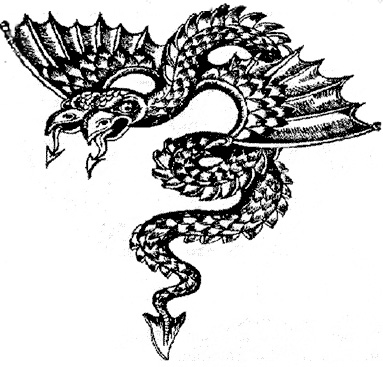
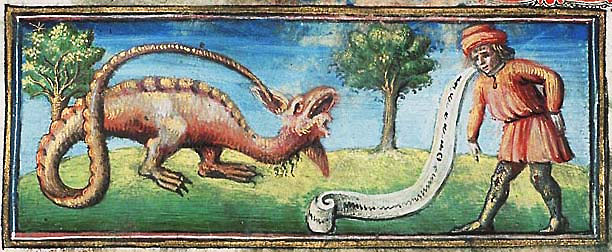

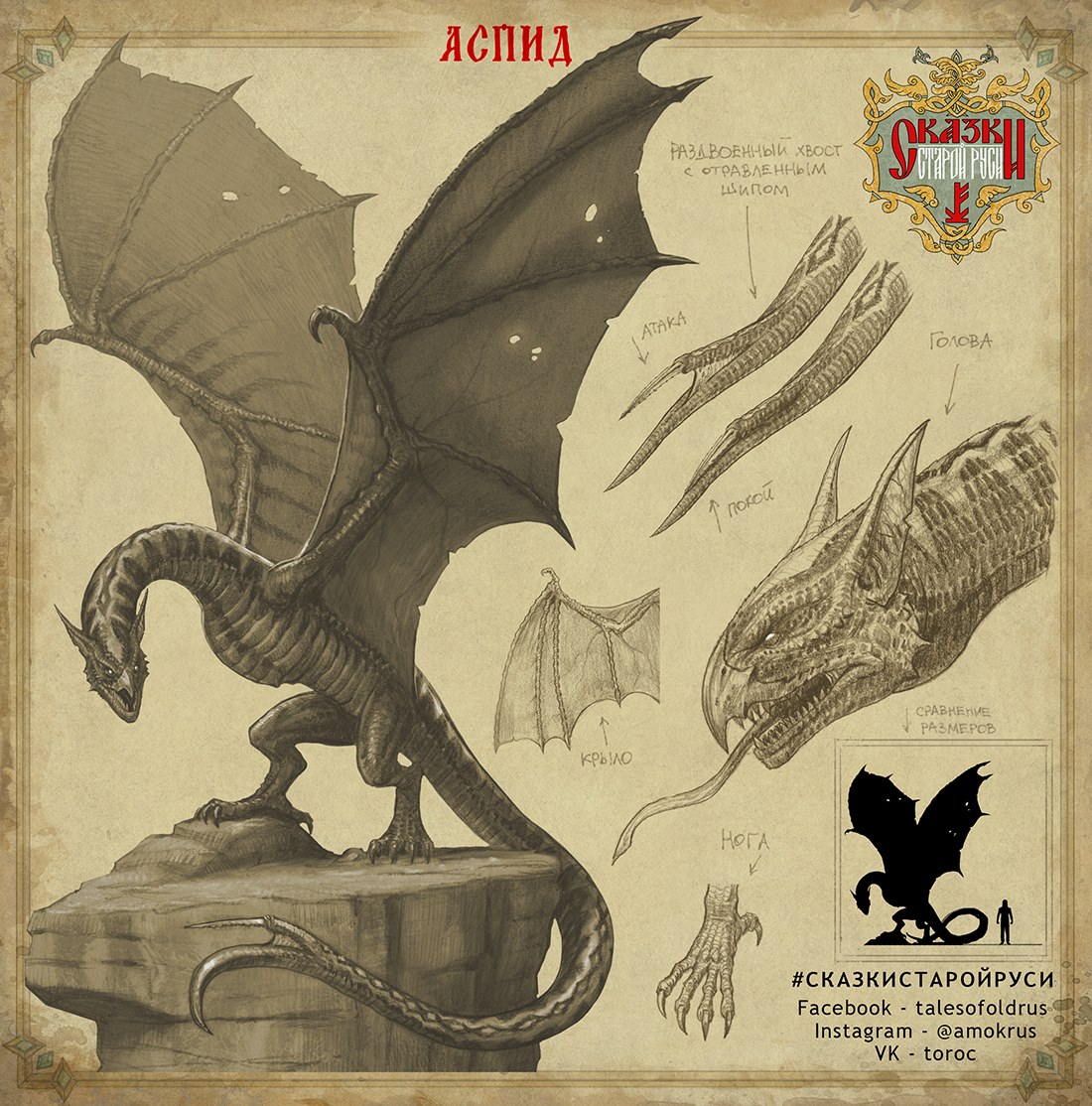



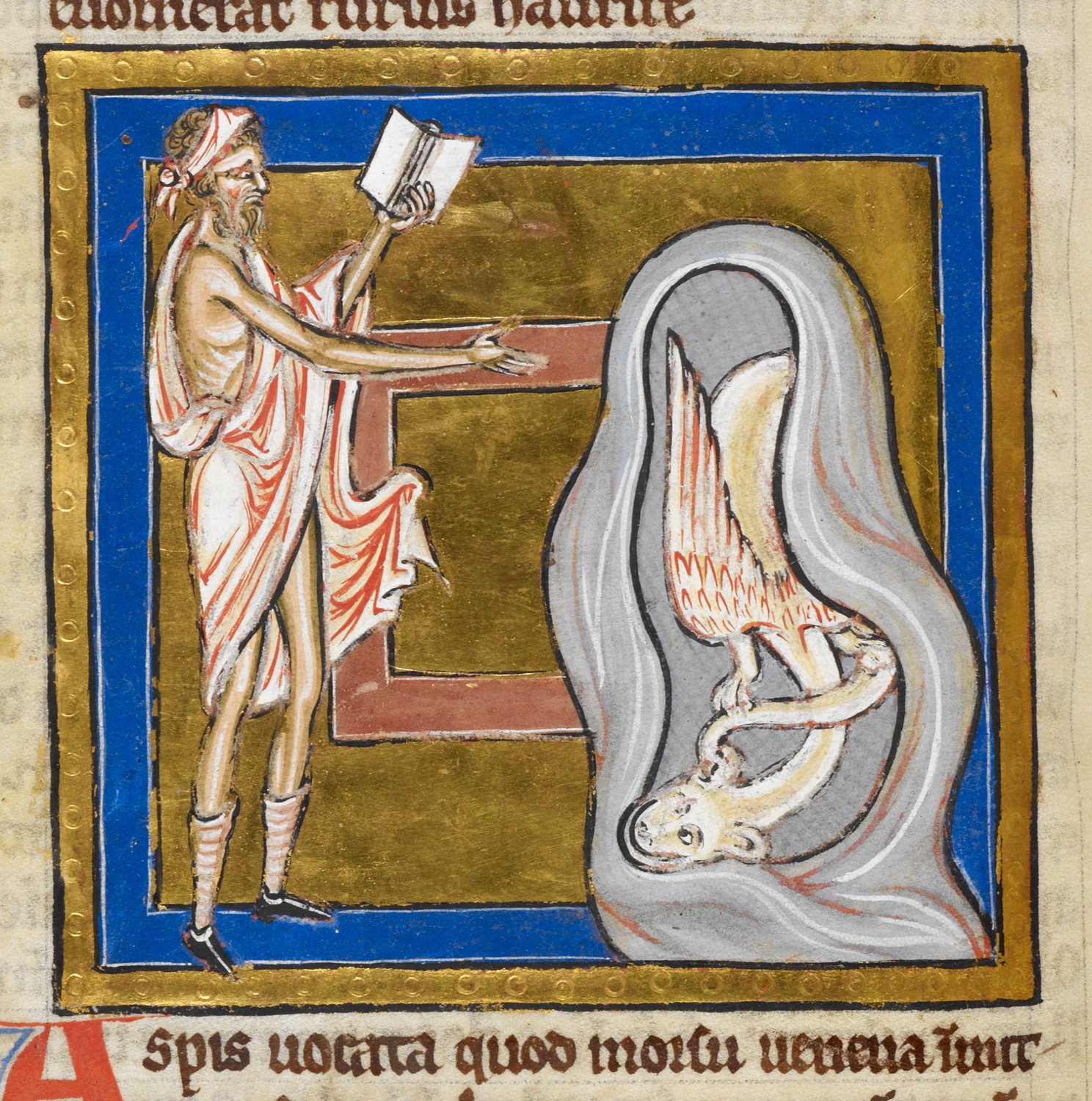
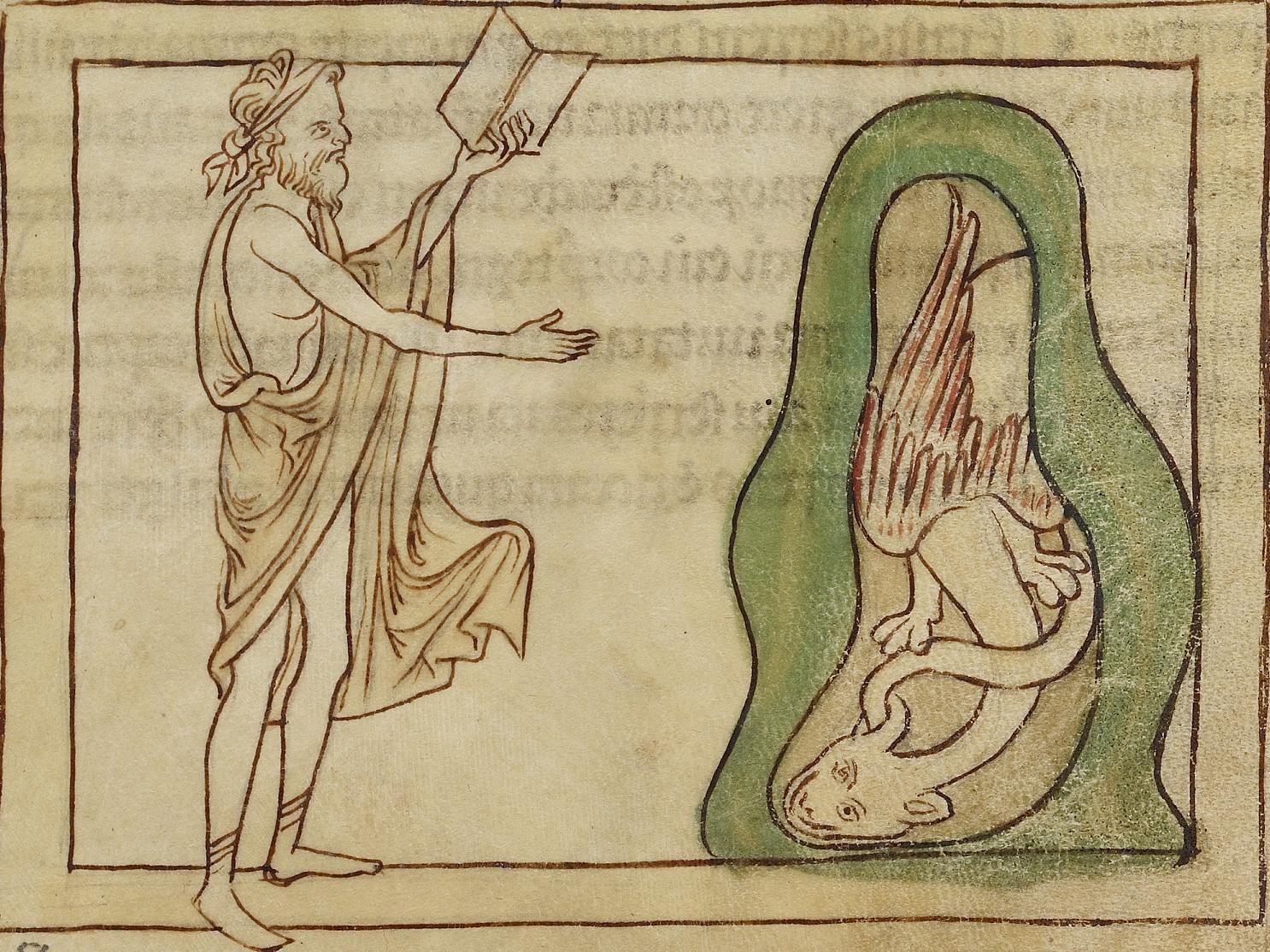

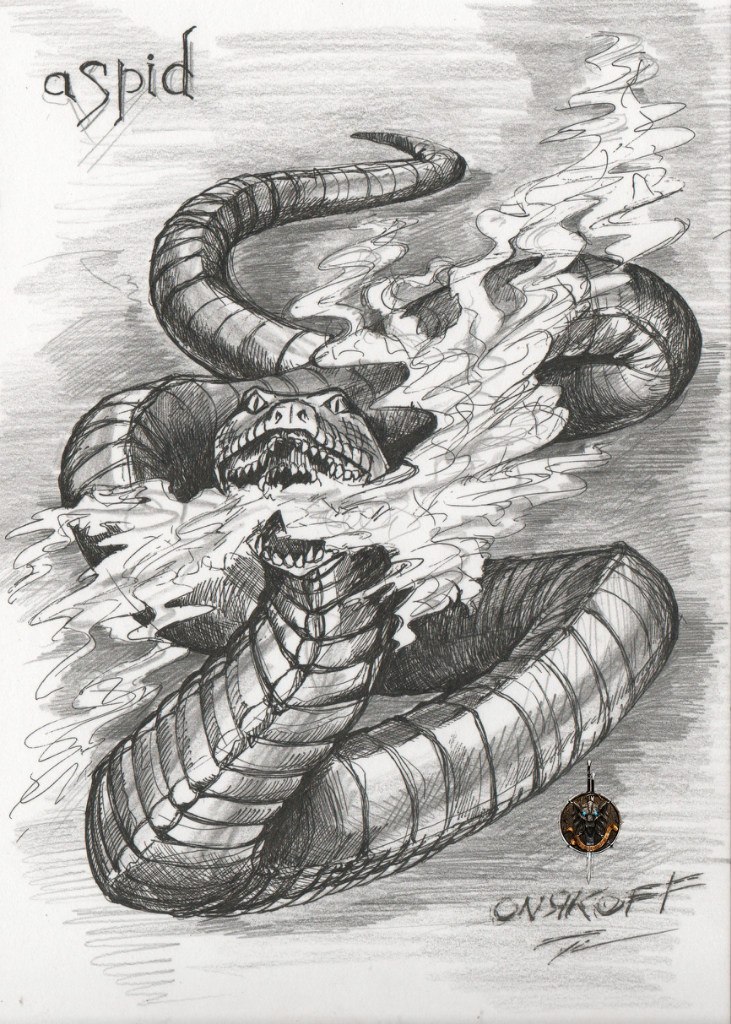


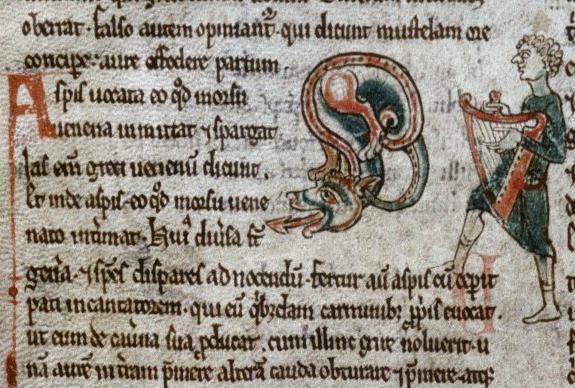

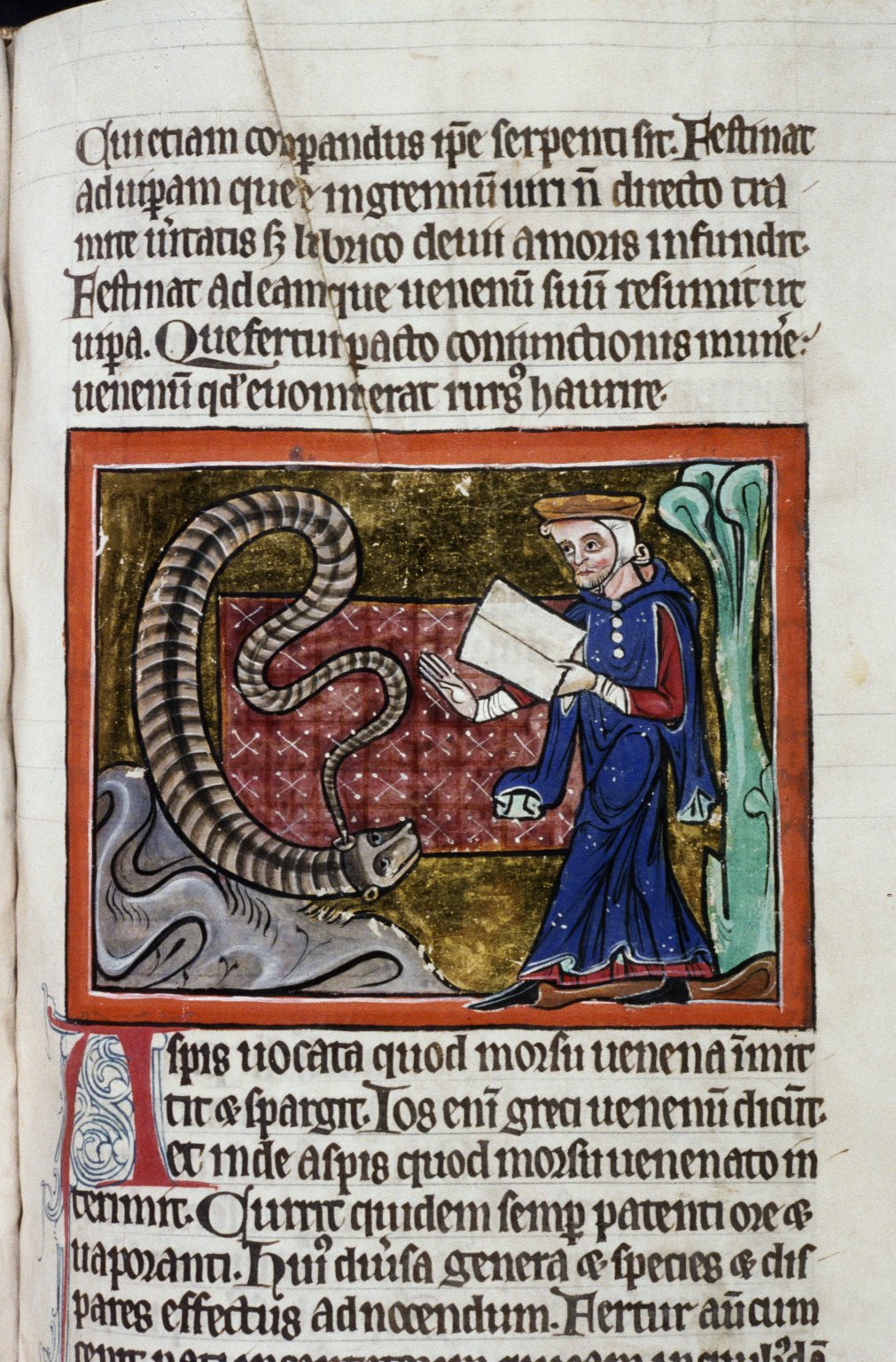
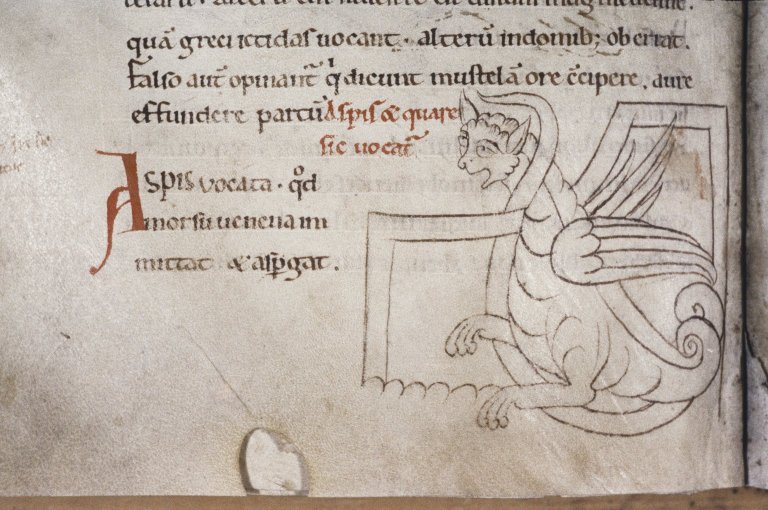
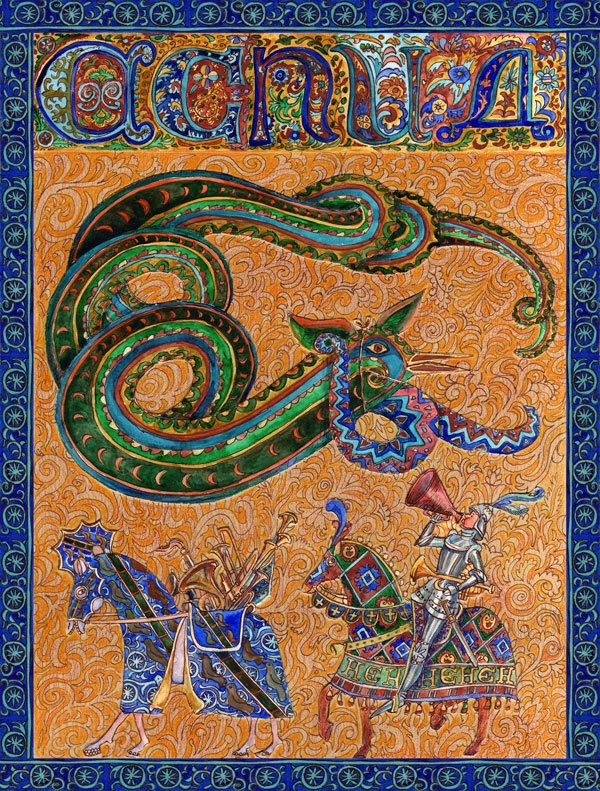






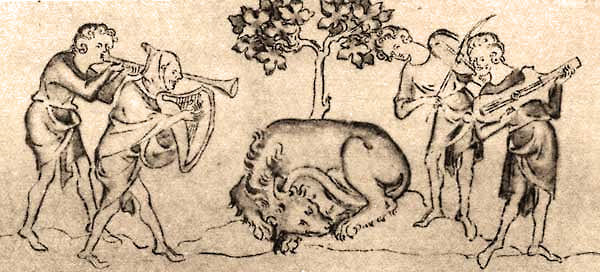




Comments
Аспид в средневековых европейских бестиариях:
General Attributes
The asp is a serpent that avoids the enchantment of music by pressing one ear against the ground and plugging the other ear with its tail. In some versions the asp guards a tree that drips balm; to get the balm men must first put the asp to sleep by playing or singing to it. Another version holds that the asp has a precious stone called a carbuncle in its head, and the enchanter must say certain words to the asp to obtain the stone.
The Haemorrhois, Prester and Hypnalis are other varieties of asp. As noted in the Aberdeen Bestiary: "The emorrosis is an asp, so called because it kills by making you sweat blood. If you are bitten by it, you grow weak, so that your veins open and your life is drawn forth in your blood. For the Greek word for 'blood' is emath…. The prester is an asp that moves quickly with its mouth always open and emitting vapour… If it strikes you, you swell up and die of gross distention, for the swollen body putrefies immediately after… There is a kind of asp called ypnalis, because it kills you by sending you to sleep. It was this snake that Cleopatra applied to herself, and was released by death as if by sleep."
Allegory/Moral
The asp represents the worldly and wealthy, who keep one ear pressed to earthly desire, and whose other ear is blocked by sin.
Sources (chronological order)
Bible (Psalm 58:5–6): "…they are like the deaf adder that stops her ear; which will not hearken to the voice of charmers, charming never so wisely".
Lucan [1st century CE] (Pharsalia, book 9, verse 821–839): "First from the dust was raised a gory clot / In guise of Asp, sleep-bringing, swollen of neck: / Full was the blood and thick the poison drop / That were its making; in no other snake / More copious held. Greedy of warmth it seeks / No frozen world itself, nor haunts the sands / Beyond the Nile; yet has our thirst of gain / No shame nor limit, and this Libyan death, / This fatal pest we purchase for our own". (verse 830–832): "Haemorrhois huge spreads out his scaly coils, / Who suffers not his hapless victims' blood / To stay within their veins". (verse 845–846): "Greedy Prester swells / His foaming jaws…". (verse 928–936): "…a Prester's fang / Nasidius struck, who erst in Marsian fields / Guided the ploughshare. Burned upon his face / A redness as of flame: swollen the skin, / His features hidden, swollen all his limbs / Till more than human: and his definite frame / One tumour huge concealed. A ghastly gore / Is puffed from inwards as the virulent juice / Courses through all his body…". (verse 946–955): "On Tullus great in heart, / And bound to Cato with admiring soul, / A fierce Haemorrhois fixed. From every limb, / (As from a statue saffron spray is showered / In every part) there spouted forth for blood / A sable poison: from the natural pores / Of moisture, gore profuse; his mouth was filled / And gaping nostrils, and his tears were blood. / Brimmed full his veins; his very sweat was red; / All was one wound".
Pliny the Elder [1st century CE] (Natural History, Book 8, 35): When the neck of an asp swells up, the only remedy for its sting is to immediately amputate the bitten part.
Augustine of Hippo [5th century CE] (Sermo 316:2 — In Solemnitate Stephani Martyris; Duri Iudaei in Stephanum): "Sicut enim dicuntur aspides, quando incantantur, ut non prorumpant et exeant de cavernis suis, premere unam aurem ad terram, et de cauda sibi alteram obturare, et tamen incantator producit illas…" (As indeed of asps it is said, that when they are lured by incantations, in order that they may not be drawn from their caves they press one ear to the ground, and use their tail to stop up the other, and yet the enchanter can bring it forth…). This appears to be the first time this method of blocking both ears was described.
Isidore of Seville [7th century CE] (Etymologies, Book 12, 4:12–16): The asp (aspis) kills with a venomous bite, and from this it gets its name, for the Greek word for poison is ios (as). When an enchanter calls an asp out of its cave by incantations and it does not want to go, it presses one ear to the ground and covers the other with its tail, so it cannot hear the enchantment. There are many kinds of asp, but not all are equally harmful. The dipsas is a kind of asp, called in Latin situla because one bitten dies of thirst. The hypnalis is a kind of asp that kills in sleep, as Cleopatra was freed by death as if by sleep when bitten by one. The haemorrhois is called an asp because anyone bitten by it sweats blood; for the Greek word for blood is haima. The prester (or praester) is a kind of asp that always runs with its steaming mouth open; one bitten becomes distended for rot follows the bite.
Illustration
The usual illustration of the asp shows the enchanter reading from a scroll, with the snake at his feet blocking its ears. The asp guarding the balsam tree is occasionally illustrated.
Источник: bestiary.ca
Статья по аспиду обновлена. Добавлен ряд иллюстраций из средневековых манускриптов.
Взял на себя ответственность по паспортизации персонажа чужой статьи. Классификация экспериментальная, прошу сильно не пинать )
Экстранаучная классификация
- статус — существа
- домен — животные
- тип — гады
- класс — бестиарские гады
- семейство —
- род — Аспиды
Физиология
- Птица, Лев, Змея, Собака
Строение (композиция)
- Гибридность, Драконообразность (?)
Дополнительные способности /особенности
- Музыкальность
Культурно-географическая
- Средневековые бестиарии, Славянская мифология и фольклор
A Book of Creatures: Asp (en)
Здравствуйте, у меня возник такой вопрос, почему нет цитаты из указанного источника: "Лев киевская мифы русского народа", просто я так и не нашёл цитаты с номером "58"
Отправить комментарий